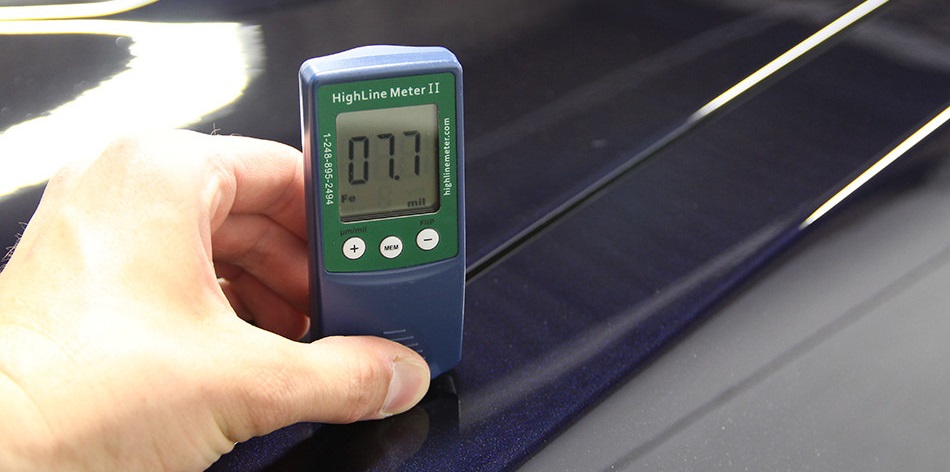We hear about this all the time, but many people are still clueless as to what it all means. Paint measurements are taken by most professionals in order to determine the thickness of paint and how much polishing/correction is safe. It’s also a great tool both for professionals and individuals to simply inspect vehicles before purchase to find any hidden body work or repainted areas. While there are normally anomalies in paint measurements even on a brand new vehicle, ranging +/- 1 Mil, measurements on repainted areas will normally give a much higher reading that indicates something was previously done.
I have had my HighLine Meter Paint Thickness Gauge for well over 3 years now and use it almost on a daily basis. We use it mainly when doing more than a 2-stage paint correction, especially on older vehicles that have a suspect paint job. However, we also use it on almost every car to simply do a thorough inspection and make sure we can report to the client if there are any panels that may be the odd one out. Since the thickness normally varies on a car, even only an inch from one another, we tend to mainly use Mils instead of Microns only to find any large differences in paint thickness. For reference, Mils are 1/1000th of an inch and Microns are 1/1000th of a millimeter, so the Mil is much larger of a measurement, 25.4 times larger than the Micron to be exact.
The main thing to mention about this gauge, and most others similar to it, is that it only measures paint as one layer. This means that on a newer car it measures the thickness of the primer, base coat and clear coat as one. This can be deceiving because we’re only working with clear coat, which means we need the measurement for that and could care less about the amount of primer or base coat on the car. There are standards out there of how much primer and base coat is normally on the car, which is anywhere from 1.0-2.2 Mils from our findings, but there are sometimes ways to make a more educated guess for the clear coat thickness. We do this by taking the measurement of the whole thickness of paint on various panels, in this case hood…
Then we take measurements of jambs as they many times have very little to no clear coat…
In this case we found the readings under the hood to be at around 3.0 Mils, which means either it’s thicker than normal for primer + base or it simply has a light layer of clear coat. The readings of all layers was averaging around 7.5, so we can safely assume there’s plenty of paint/clear coat to work with.
Now, the reason I say it’s safe is basically because from researching (paint manufacturers, reputable detailers and car manufacturers) I have found that clear coat should be a minimum of around 2.0 Mils to stay in tact. This means if you’re getting a reading of 1.5 below the hood and 3.5 on top, it’s highly likely you may degrade the clearcoat by doing some heavy polishing. By heavy polishing, I mean using a compound and a cutting pad, such as M105 and Purple Foamed Wool, but this can vary depending on the sensitivity of the paint. Some very hard clear coats can withstand a heavy polishing a lot better than other paints, so one needs to be aware of the situation. Lastly, we have found average paint jobs to be anywhere from 4.0 to upper 4s or 5.0 Mils, depending on the make, model, etc. In all my years of detailing, I’ve seen some OEM paint that’s as low as 3.5 Mils or so and then others upwards of 8-9. The thicker ones are usually higher end cars, like Bentley, Ferrari, etc.
There are expensive gauges available that read multiple layers of paint, but for typical polishing work and DIY inspections, the HighLine Meter Paint Thickness Gauge is a great tool that gives more than enough information. Hopefully this gives a better insight to the world of paint measurements and utilizing the gauge to inspect paint in general!
